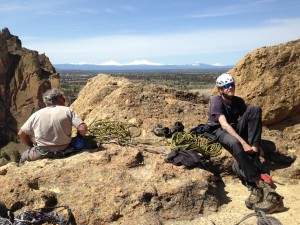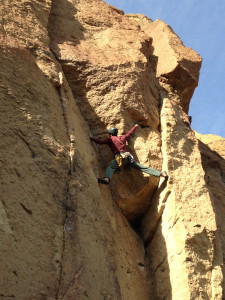Mammut 2012 Scholarship Recipient Ian Havlick on taking the Advanced Alpine Guide Course
Ian Havlick was the 2013 Mammut Scholarship recipient. Here is the account from his Rock Instructor Course.
 In late April 2013, I made the drive from Crested Butte, Colo., in south Central Colorado, to central Oregon and Smith Rock State Park, where the American Mountain Guides Association hosted the entry-level course for the rock and alpine disciplines. I have been guiding for the last six years. My most recent guiding job brought me to Crested Butte, where I was employed as a ski guide for Irwin Backcountry Guides. This fairly new operation specializes in high end luxury outdoor experiences that are “off the beaten path”. It completely “bespoke” adventures where the client comes to Irwin with an idea what they want, and the guides and support staff customize and tailor their abilities and time constraints to create a one of a kind experience. This operation began as a purely winter guide service offering clients cat skiing, snowmobiling, and backcountry skiing, but has matured into a year-round outfitting service looking to provide rock climbing, alpine climbing, fly fishing, as well as mountain biking, kayaking, rafting, hiking, etc. I grew up in Colorado with my strengths being skiing and endurance sports, so I knew I would be challenged when I enrolled in this rock instructor course, but with the turn my guide service was taking transitioning into a strong technical rock outfitter, it was an overdue step to take in order to continue to provide safe, high end adventures when the days get longer and the snow melts away.
In late April 2013, I made the drive from Crested Butte, Colo., in south Central Colorado, to central Oregon and Smith Rock State Park, where the American Mountain Guides Association hosted the entry-level course for the rock and alpine disciplines. I have been guiding for the last six years. My most recent guiding job brought me to Crested Butte, where I was employed as a ski guide for Irwin Backcountry Guides. This fairly new operation specializes in high end luxury outdoor experiences that are “off the beaten path”. It completely “bespoke” adventures where the client comes to Irwin with an idea what they want, and the guides and support staff customize and tailor their abilities and time constraints to create a one of a kind experience. This operation began as a purely winter guide service offering clients cat skiing, snowmobiling, and backcountry skiing, but has matured into a year-round outfitting service looking to provide rock climbing, alpine climbing, fly fishing, as well as mountain biking, kayaking, rafting, hiking, etc. I grew up in Colorado with my strengths being skiing and endurance sports, so I knew I would be challenged when I enrolled in this rock instructor course, but with the turn my guide service was taking transitioning into a strong technical rock outfitter, it was an overdue step to take in order to continue to provide safe, high end adventures when the days get longer and the snow melts away.
 I arrived at Smith Rock after a stop for supplies in Bend, Ore., then made the easy 30-minute drive north, past Redmond, and into the tiny town of Terrebonne, the nearest town to Smith Rock State Park. The Park itself remains in immaculate shape despite the large influx of people here, especially in spring, when Portland, Madras, and Bend remain a bit chilly to climb and the warm Smith Rock routes beckon. Smith has a famous and storied history as a hotbed for American sport climbing and difficult pioneering routes on its unique rock: a compressed, and then subsequently eroded, golden volcanic ash, named welded Tuff. Smith holds world-class sport routes, but I also found the multipitch traditional routes extremely fun and unique. Adding to the value of this course is the huge benefit of having a pretty luxurious bivouac zone complete with hot (warm to kinda cold) showers, as well as flush toilets and an outdoor sink to clean dishes, fill water bottles, immediately adjacent to the trailhead to the crags.
I arrived at Smith Rock after a stop for supplies in Bend, Ore., then made the easy 30-minute drive north, past Redmond, and into the tiny town of Terrebonne, the nearest town to Smith Rock State Park. The Park itself remains in immaculate shape despite the large influx of people here, especially in spring, when Portland, Madras, and Bend remain a bit chilly to climb and the warm Smith Rock routes beckon. Smith has a famous and storied history as a hotbed for American sport climbing and difficult pioneering routes on its unique rock: a compressed, and then subsequently eroded, golden volcanic ash, named welded Tuff. Smith holds world-class sport routes, but I also found the multipitch traditional routes extremely fun and unique. Adding to the value of this course is the huge benefit of having a pretty luxurious bivouac zone complete with hot (warm to kinda cold) showers, as well as flush toilets and an outdoor sink to clean dishes, fill water bottles, immediately adjacent to the trailhead to the crags.
The course was taught by three IFMGA certified guides who work in different aspects the mountain guiding profession, and all complemented each other very well. Angela Hawse and Tom Hargis have climbed and guided all over the world from the Tetons to the Himalaya, where Steve Banks is a professional within the United States, Canada, and Europe. The instructor team was patient and had considerable knowledge, whether the topic of the day be the intricacies of rock rescue, guiding multiple clients, climbing technique, or equipment.
The biggest take away from this super valuable 10-day course was climbing consistently with high level students and instructors to the standard of professionals all over the world. Additionally, establishing good habits and thinking through the process logically, knowing what needs to be done and digging into my new bag of tricks, confidently, is peace of mind well worth the investment of time and money.

I am extremely indebted to Mammut and the AMGA for providing financial assistance to pay for this huge step in the professional track of guiding and hope this course spring boards me into more guiding around the world. I also hope it allows me to further pursue the AMGA/IFMGA education pipeline, with the ultimate goal of obtaining IFMGA certification and the flexibility that credential provides myself and my clients with work and new places to explore.
Lee Lazzara was the 2012 Mammut Scholarship Recipient. He sent us this testimonial:
There’s nothing like a home field advantage. If only I had a dollar for every time I’ve had to listen to other AMGA course participants (and instructors) give me a hard time about being a full-time Bellingham resident–about the rain and the moss that’s growing in the seams of my Honda, about the wet goopy snow, and the 50 good days a year to go rock climbing (maybe), about the chossy rock of North Cascades National Park.
Despite all this, I will say my time in this corner of the North Cascades has thus far given me all the preparation and training I’ve needed as I work my way through all three disciplines of IFMGA certification. Minimal travel to glaciated terrain, big mountain ski descents (3,000 feet is not big by the way), real alpine shenanigans and “decent” rock climbing when it’s not raining (Squamish is only an hour and a half away from home). Plus, I already know where the Fisher Chimneys start and where to get the best tacos on Highway 20…

But the biggest help in this whole process was receiving the 2012 Mammut Scholarship to cover the tuition of the Advanced Alpine Guide Course/Aspirant Exam held right here in my backyard.
One AMGA course/exam per year is expensive. Three course/exams is really expensive. In addition to the program costs we all know too well, there are travel expenses, time, and resources dedicated to training/resume requirements, plus all the time not guiding–work much needed to pay the whole thing off without selling one’s soul to THE MAN via the Hell’s Highway of compounding credit card debt (Alpine Discipline pun definitely intended).
With no scholarship, living far away, I would have had to put down $2,400 for course tuition, hundreds more for gas to drive a Toyota or Nissan or whatever truck from Colorado and back, not to mention necessary extras like hotel rooms, dinners out, etc. Instead, the Mammut Scholarship let me keep the bills down to a tank of gas for the Honda and a food buy at Trader Joe’s. Sleeping at home or staying with friends on town nights, home cooked meals from time to time during the 12-day program. It all added up to $125 or so. The biggest hassle was my girlfriend asking me to take the dog for a walk as I headed out the door on the first dayof the Aspirant Exam.

But, of course, the real outcomes of an AMGA program are not about dollars or convenience or how “good you have it.”
There was the time spent on unknown routes wedged in between the classics I’ve always climbed, a sense of adventure–or was it merely choss induced fear?–when much of the terrain around us was so familiar.
We also were granted the gift of having our course and aspirant exam during The Great High Pressure of 2012–in 11 field days we had one day of low, misty clouds in Boston Basin and one day of inconsequential snow in Washington Pass. The rest of the time we had Splitter. Blue. Skies. And sun.

Many thanks to the AMGA and Mammut for making the Advanced Alpine Course happen for me in 2012! A few of us even got to assist a single, overwhelmed NPS climbing ranger with the rescue and extraction of a Korean climber who tumbled down a good portion of a pitch starting the Torment-Forbidden Traverse. It was interesting to apply that first responder skill set after a full day of guiding, being guided, and dodging loose rock. A full patient assessment, interviewing the victim’s climbing partner, and short roping the Victor down the glacier to a suitable LZ were some of the tasks we helped with that evening.
But, most importantly was the opportunity to learn and apply guiding skills in challenging alpine terrain with knowledgeable guidance. To be able to turn to an instructor in a section of terrain I’ve traveled through so many times and ask for that one trick that would make the process safer and efficient was invaluable.













